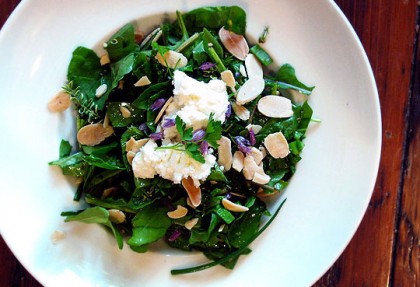There are twenty-five different species of mint and many more varietals. Some of the most popular are:
- peppermint (Mentha piperita oficinalis)
- spearmint (Mentha spicata)
Both peppermint and spearmint have smooth, green teardrop-shaped leaves with jagged edges. And while they taste slightly differently, they both have that fresh, crisp flavor which has made mint so popular in breath fresheners,
cocktails, and
desserts.
There’s more to mint than peppermint tea! Mint is a wonderful addition to all kinds of recipes. Refreshing in homemade mint ice cream or a fresh fruit salad, mint can also be used in more savory contexts. Chopped fresh mint can be tossed with roasted or grilled vegetables for a simple side dish, and mint makes a wonderful and easy garnish for curries and other spicy dishes. If you want to try something a bit more challenging, attempt a “raita” or mint chutney; simply blend mint, yogurt, garlic, salt, and chiles for a delicious accompaniment to South Asian dishes like butter chicken or curried eggplant. And don’t forget, fresh mint is essential to any good mojito!
Mint teas have long been believed to be both relaxing and healthy. Hot mint tea can soothe a sore throat, but there’s nothing more relaxing than iced mint tea on a summer’s day. Try mixing up a batch by steeping mint leaves in boiling water and then adding honey to taste. Once this brew cools, mix with fresh chopped mint leaves, lots of ice, and a spurt of lemon or lime juice.
Mint is one of the few herbs that does well in shade, so it’s perfect for that empty spot of ground right next to the house. Mint can be grown easily from cuttings or root divisions, but it takes a long time for mint seeds to germinate. To grow from cuttings, simply stick small leaf stems directly into the ground. Keep mint moist and well fertilized.
Mint is a hardy plant, but it is prone to a fungus known as “mint rust” that causes reddish-orange spots to form on the leaves. Mint rust is unsightly but usually won’t kill the plant. If your mint has contracted mint rust, it should be uprooted and burned so that the fungus doesn’t spread to the lovely leaves of nearby mint plants.
Some really exciting species and varietals of mint are available at farmers’ markets these days. Check and see if yours has any of the following:
- Apple mint (Mentha rotundifolia)
- with soft, fuzzy leaves, it’s not the best choice for cooking, but it does smell like a mini-apple orchard.
- Basil mint (Mentha spicata subsp.)
- okay, so maybe it doesn’t taste exactly like basil and mint, but it does have a special, spicy quality to it.
- Chocolate mint (Mentha piperita subsp)
- with a pretty brownish-green leaf, this varietal really does look and taste like chocolate and mint.
- Lemon mint (Mentha citrata)
- has a fresh lemon odor when crushed and can be used to make a tea similar to the one made with lemon verbena.
- Pineapple mint (Mentha suaveolens)
- with white edging around its leaves, this mint is beautiful with a hint of tropical pineapple offsetting its minty fresh taste.


